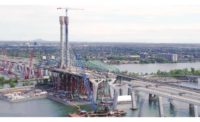From the pilings to the deck and everything in between, a $6- million, federally funded project will serve as a test bed for a variety of fiber-reinforced polymer (FRP) and composite technologies while replacing an existing 54-year-old vehicular bridge in southern Florida.
Construction began on Jan. 9 on the new, 186-ft-long Halls River Bridge in Homassasa, Fla. “The long-term goal is the corrosion-resistance the design will provide against chlorides from saltwater,” says Richard Frank, co-construction manager for the Florida Dept. of Transportation. FDOT’s District 7 alone spent about $100 million on corrosion repairs in the past 14 years.
FDOT originally intended to build the new bridge to test the Hybrid Composite Beam (HCB), a glass-fiber-reinforced plastic shell with high-strength, continuous steel fibers placed along the bottom flange and filled with self-consolidating concrete (ENR 4/12/10 p. 34). The bridge’s five spans will consist of nine 36-ft HCBs fabricated by authorized manufacturer Kenway Corp.
“FDOT in 2013 made a leap of faith and said they would like to try an HCB bridge in District 7,” says John Hillman, HCB’s inventor. “FDOT stepped up to the plate and said, ‘We’d like to be the engineer of record.’ We often have had to roll the cost of design into our product or help a DOT secure a design firm comfortable with technology. We gave FDOT the preliminary design and provided checking and guidance.”
Then, FDOT decided to go further and, in lieu of steel, use glass- or concretefiber-reinforced polymers (GFRP or CFRP) to reinforce the concrete deck piles, sheet piling, abutments, railing and approach slabs.
“This has transformed into a showcase of technology, from the piles to the caps to the deck to the railing,” says Antonio Nanni, chair of the engineering college at the University of Miami, which is participating in project monitoring.
Contractor Astaldi Construction Corp. on Jan. 9 began work on the flat slab bridge supported on driven piles. “A pile-driving program will commence, with a minimum depth of 27 feet,” says Zachary Stringer, co-construction manager with FDOT. “Carbon FRP will be used on the pilings.”
The carbon-fiber composite cable (CFCC) is “a stranded polymer that consists of twisted fibers and thermosetting epoxy resin,” says Yoshiaki Yamamoto, president and CEO of Tokyo Rope USA, the manufacturer. CFCC is non-corrosive, lightweight and flexible, he adds. For the Halls River Bridge, CFCC will serve as prestressing strands for precast-concrete piles and precast-concrete sheet piles.
The product was first deployed on a bridge in Michigan in 2001. As of this year, there will be 21 applications in the U.S., says Yamamoto. CFCC can be easily wound into a coil or on a reel, he adds. Jacksonville-based Gate Precast Co. will install the 18-in.-dia piles from 55 ft to 70 ft deep. “We got this job mainly because of our past experience using carbon-fiber materials,” says Scott Henning, plant manager for Gate Precast.
Gate Precast crews will helically wind a 15-millimeter-dia, seven-cord CFCC—that is, six carbon-fiber cords wrapped around a central straight cord—to prestress the piles longitudinally. Twelve CFCC strands will stretch along the pile’s perimeter, and a 5-mm-dia cord will wind along the length of the pile.
The contractor will convert the existing two-lane bridge into a two-way one-lane bridge and remove half the old bridge; next, the contractor will build the northern half of the new bridge. “Then, [Astaldi] will take the traffic and move it to a two-way, two-lane condition, demolish the other half and construct the southern half,” says Stringer.
Scheduled for completion in November, the bridge is expected to carry about 4,500 vehicles a day.
Before launching the project, the University of Miami and Florida State University helped FDOT to test the GFRP and CFRP components. Contractor crews also will cast test sections during the project, adds Frank. “There are different kinds of reinforcements that the university students will remove at intervals after exposure and run tests to see how they perform.”
FRP components already are showcased on the University of Miami campus in a 70-ft-long footbridge, built last year. The American Concrete Institute has been studying FRP-reinforced concrete for more than 25 years, “but we never had an opportunity to demonstrate it on campus to a community interested in deployment and implications,” says Nanni. “We created a unique structure with not a single pound of steel—only concrete and composites in the forms of prestressed and non-prestressed FRP cables.”
The major barrier to FRPs becoming mainstream has long been the initial cost (ENR 5/24/10 p. 22). FDOT says the Halls River Bridge will cost $221 per sq ft, compared to $166 sq ft for a conventional concrete-and-steel bridge. But it is expected to last at least 75 years with minimal maintenance in a saltwater, corrosive environment.
Responding to concerns that steel is being upended, Nanni says, “We want to make structures durable and sustainable. In some instances, steel is marvelous. But corrosion is something we cannot resolve [with steel reinforcements] when a structure is exposed to chlorides like seawater or deicing salts. Composites serve the purpose where corrosion is a problem.”







Post a comment to this article
Report Abusive Comment